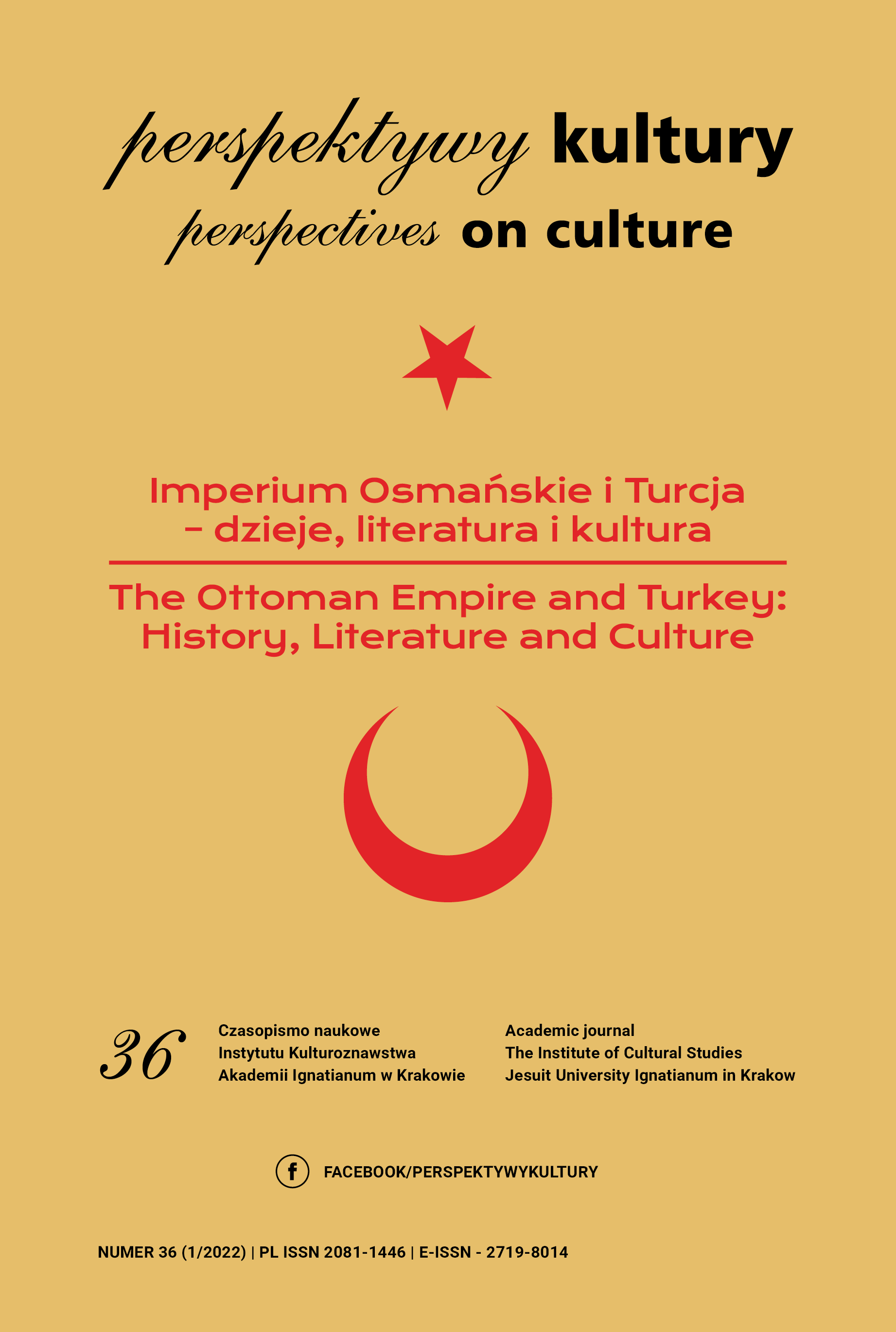Wielka polityka wokół Cypru. Imperium Osmańskie i Wenecja w zmaganiach o wyspę (1570–1573)
Abstrakt
Celem niniejszego artykuł jest przybliżenie roli, jaką odgrywał Cypr w rywalizacji pomiędzy Imperium Osmańskim, znajdującym się w XVI w. w apogeum swojego rozwoju, a siłami chrześcijańskimi w basenie śródziemnomorskim, w szczególności zaś Republiką Wenecką. Bitwa pod Lepanto jest jednym z etapów tej rywalizacji, która zakończyła się istotnymi zmianami w układzie strategicznym i ekonomicznym we wschodniej części basenu Morza Śródziemnego. W artykule nawiązano do przyczyn tej rywalizacji, wojny o Cypr, bitwy pod Lepanto oraz wskazano również na istotny wątek samej bitwy poruszony w sztuce polskiej, również w kontekście metaforycznym. Artykuł w podsumowaniu wskazuje na następstwa upadku wyspy i znalezienia się jej w składzie prowincji Imperium Osmańskiego.
Bibliografia
Alastos, D. (1955). Cyprus in history. A survey of 5000 years. London: Publisher Zeno.
Arbel, B. (1989). Résistance ou collaboration? Les Chypriotes sous la dominacion vénitienne. In: M. Balard (ed.), Etat et colonization au Moyen Age à la Renaissance. Lyons: La Manufacture, 131–143.
Arbel, B. (1995). Trading Nations: Jews and Venetians in the Early Modern Eastern Mediterranean. Leiden–Koln–New York: Brill.
Arbel, B. (1996). The Economy of Cyprus during the Venetian Period (1473– 1571). In: V. Karageorghis & D. Michaelides (eds.), The Development of the Cypriot Economy from the Prehistoric Period to the Present Day. Nicosia: University of Cyprus and Bank of Cyprus, 185–192.
Arbel, B. (2000). The Jews in Cyprus: New Evidence from the Venetian Period. In: B. Arbel (ed.), Cyprus, the Franks and Venice, 13th–16th Centuries. Aldershot–Burlington: Ashgate, 23–40.
Arbel, B. (2001). Jews in International Trade: The Emergence of the Levantines and Ponentines. In: R. Davis & B. Ravid (eds.), The Jews of Early Modern Venice. Baltimore–London: Johns Hopkins University Press, 73–96.
Arbel, B. (2017a). Cyprus on the Eve of the Ottoman Conquest. In: B. Arbel (ed.), Studies on Venetian Cyprus. Nicosia: Cyprus Research Centre, 273–286.
Arbel, B. (2017b). What Happened to Famagusta’s Jews Following the Ottoman Conquest of 1571? In: B. Arbel (ed.), Studies on Venetian Cyprus. Nicosia: Cyprus Research Centre, 331–341.
Burkiewicz, Ł. (2008a). Na styku chrześcijaństwa i islamu. Krucjaty i Cypr w latach 1191–1291. Kraków: Towarzystwo Wydawnicze Historia Iagellonica przy Instytucie Historii Uniwersytetu Jagiellońskiego.
Burkiewicz, Ł. (2008b). The Cypriot Jews under the Venetian Rule (1489– 1571). Scripta Judaica Cracoviensia, 6, 49–61.
Burkiewicz, Ł. (2010). Królestwo Cypru jako obiekt zainteresowań państw śródziemnomorskich w latach 1192–1489. Próba zarysowania problemu. Prace Historyczne Uniwersytetu Jagiellońskiego, 137, 27–42.
Burkiewicz, Ł. (2011a). Polski epizod w cypryjskich dążeniach do zrzucenia zwierzchnictwa sułtanatu mameluków. Studia Gdańskie, 29, 163–182.
Burkiewicz, Ł. (2011b). A Cypriot royal mission to the Kingdom of Poland in 1432. Crusades, 10, 103–112.
Burkiewicz, Ł. (2014a). Cypr pod panowaniem dynastii Lusignanów i Republiki Wenecji (1192–1571). In: M. Borowska, P. Kordos, & D. Maliszewski (eds.), Cypr: dzieje, literatura, kultura. T. 1. Warszawa: Sub Lupa, 243–264.
Burkiewicz, Ł. (2021). “Inde insulam Cyprum inter Graecos et Sarraticos (Sarracenos)…” Cyprus in 724 AD as Seen by the English Monk Willibald. Perspektywy Kultury, 2 (33), 153–173.
Burkiewicz, Ł. & Kostopoulou, A. (2014b). Οι φιλοδοξίες των ηγεμόνων της Σαβοΐας για το στέμμα της Κύπρου. Επετηρίς της Κυπριακής Εταιρείας Iστoρικώv Σπoυδώv, 11, 105–112.
Coureas, N. (2005). Apple of Concord: The Great Powers and Cyprus, 400– 1960. Κυπριακαί Σπουδαί, 67–68, 447–462.
Coureas, N. & Riley-Smith, J. (eds.). (1995). Cyprus and the Crusades. Nicosia: Cyprus Research Centre and SSCLE.
Edbury, P.W. (1991). The Kingdom of Cyprus and the Crusades, 1191–1374. Cambridge: University Press.
Edbury, P.W. (1993). The Lusignan Kingdom of Cyprus and its Muslim Neighbours. Nicosia: Bank of Cyprus Cultural Foundation.
Edbury, P.W. (1999). Kingdoms of the Crusaders: from Jerusalem to Cyprus. Aldershot: Variorum, Ashgate.
Enlart, C. (1987). Gothic Art and the Renaissance in Cyprus. Transl. D. Hunt. London: Trigraph in association with the A.G. Leventis Foundation.
Foglietta, U. (1903). The Sieges of Nicosia and Famagusta. London: Waterlow and Sons.
Hill, G. (1940). A History of Cyprus. Vol. 1: To the Conquest by Richard Lion Heart. Cambridge: University Press.
Hill, G. (1948a). A History of Cyprus. Vol. 2: The Frankish Period, 1192–1432. Cambridge: University Press.
Hill, G. (1948b). A History of Cyprus. Vol. 3: The Frankish Period, 1432–1571. Cambridge: University Press.
Hunt, D. & Hunt, I. (eds.). (1989). Caterina Cornaro, Queen of Cyprus. London: Trigraph in association with The Bank of Cyprus.
Jeffery, G. (1973). Cyprus under an English King in the Twelfth Century. The Adventure of Richard I. and the Crowning of His Queen in the Island. London: Zeno.
Luke, H. (1921). Cyprus under the Turks, 1571–1878. Oxford–New York: Oxford University Press.
Metcalf, D.M. (2009). Byzantine Cyprus, 491–1191. Nicosia: Cyprus Research Centre.
Misztal, M. (2013). Historia Cypru. Kraków: Wydawnictwo Naukowe Uniwersytetu Pedagogicznego.
Monellog, G. (2006). Accadde a Famagosta, l’assedio turco ad una fortezza veneziana ed il suo sconvolgente finale. Cagliari: Scepsi & Mattana.
Orr, C.W.J. (1970). Cyprus Under British Rule. London: Published by Zeno Publishers.
Panteli, S. (2003). Joseph Nasi, „King Aspirant” of Cyprus, and the Ottoman Expedition of 1570–1571. In: S. Panteli (ed.), Place of refuge: a history of the Jews in Cyprus. London: Elliott & Thompson, 44–62.
Parny, J. (1976). The Successors of Sulaimān, 1566–1617. In: M.A. Cook (ed.), A History of the Ottoman Empire to 1730. Cambridge–London–New York– Melbourne: Cambridge University Press, 103–132.
Perbellini, G.M. (1994). The Fortress of Nicosia, Prototype of European Renaissance Military Architecture. Nicosia: Zavallis.
Pernoud, R. (1994). Ryszard Lwie Serce. Warszawa: Państwowy Instytut Wydawniczy.
Raszewski, J. (2014). Cypr w okresie bizantyńskim (330–1191). In: M. Borowska, P. Kordos, & D. Maliszewski (eds.), Cypr: dzieje, literatura, kultura. Vol. 1. Warszawa: Sub Lupa, 227–242.
Richard, J. (1977). Chypre du protectorat à la dominaton vénitienne. In: J. Richard (ed.), Les relations entre l’Occident et l’Orient au Moyen Âge. London: Variorum, 657–677.
Richard, J. (1997). Les révoltes chypriotes de 1191–1192 et les inféodations de Guy de Lusignan. In: B.Z. Kedar, J. Riley-Smith, & R. Hiestand (eds.), Montjoie. Studies in crusade history in honour of Hans Eberhard Mayer. Aldershot: Variorum, 123–128.
Sachs-Collignon, J. (1995). Caterina Cornaro: Konigin von Zypern, Herrin von Asolo: ein Roman aus italienischen Renaissance. Muhlacker: Stieglitz-Verl.
Stankiewicz, A. (2020). „Bitwa pod Lepanto” Tomasza Dolabelli z kaplicy różańcowej przy kościele podominikańskim w Poznaniu. Seminare. Poszukiwania naukowe, 41 (3), 141–158.
Wilczyński, L. (2003). Muzeum Archidiecezjalne w Poznaniu w okresie II Rzeczypospolitej. Poznańskie Studia Teologiczne, 15, 191–209.
Ziada, M.M. (1933). The Mamluk Conquest of Cyprus in the fifteenth century. Bulletin of Faculty of Arts, University of Egypt, 1, 90–113.
Ziada, M.M. (1934). The Mamluk Conquest of Cyprus in the fifteenth century. Bulletin of Faculty of Arts, University of Egypt, 2, 37–58.
Żmudziński, J. (2009). O potrzebie badań nad twórczością Tomasza Dolabelli. Ze studiów nad obrazami w kościele Mariackim i kościele Kamedułów na Bielanach w Krakowie. Folia Historiae Artium. Seria Nova, 12, 123–144.
Żmudziński, J. (2011). Wystrój malarski kaplic kościoła Kamedułów na Bielanach i jego znaczenie dla sztuki Krakowa 1. połowy XVII w. (kaplice Królewska i Delpacowska). Folia Historica Cracoviensia, 17, 79–118.
Żmudziński, J. (2012). Jak malował Tomasz Dolabella i co nowego wniósł do sztuki polskiej pierwszej połowy XVII wieku? In: I. Rolska & K. Gombin (eds.), Studia nad sztuką renesansu i baroku. Vol. 11: Tradycja i innowacja w sztuce nowożytnej. Lublin: Towarzystwo Naukowe Katolickiego Uniwersytetu Lubelskiego Jana Pawła II, 493–524.
Żmudziński, J. (2016). Dzieła Tomasza Dolabelli i artystów z jego kręgu na ziemiach południowo‑wschodniej Rzeczypospolitej. Ze studiów nad recepcją weneckiego manieryzmu w malarstwie polskim 1. połowy XVII w. In: P. Łopatkiewicz (ed.), Artyści włoscy na ziemiach południowo‑wschodniej Rzeczypospolitej. Rzeszów–Łańcut: Stowarzyszenie Historyków Sztuki, 225–245.
Żmudziński, J. (2017). Ze studiów nad malarskim wystrojem kościoła para‑ fialnego w Kraśniku (dzieła Tomasza Dolabelli i Jana Krasińskiego). Archiwa, Biblioteki i Muzea Kościelne, 108, 367–388.
Copyright (c) 2022 Akademia Ignatianum w Krakowie

Utwór dostępny jest na licencji Creative Commons Uznanie autorstwa 4.0 Międzynarodowe.
Autor, zgłaszając swój artykuł, wyraża zgodę na korzystanie przez Wydawnictwo Uniwersystet Ignatianum z utworu na następujących polach eksploatacji:
- utrwalania utworu w formie papierowej, a także na nośniku cyfrowym lub magnetycznym;
- zwielokrotnienia utworu dowolną techniką, bez ograniczenia ilości wydań i liczby egzemplarzy;
- rozpowszechniania utworu i jego zwielokrotnionych egzemplarzy na jakimkolwiek nośniku, w tym wprowadzenia do obrotu, sprzedaży, użyczenia, najmu;
- wprowadzenia utworu do pamięci komputera;
- rozpowszechniania utworu w sieciach informatycznych, w tym w sieci Internet;
- publicznego wykonania, wystawienia, wyświetlenia, odtworzenia oraz nadawania i reemitowania, a także publicznego udostępniania utworu w taki sposób, aby każdy mógł mieć do niego dostęp w miejscu i czasie przez siebie wybranym.
Wydawca zobowiązuje się szanować osobiste prawa autorskie do utworu.






